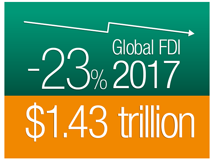UNCTAD World Investment Report out now
06 Jun 2018Global foreign direct investment (FDI) flows fell by 23% in 2017, to $1.43 trillion from $1.87 trillion in 2016, according to UNCTAD’s World Investment Report 2018. The decline is in stark contrast to other macroeconomic variables, which saw substantial improvement in 2017.
“Downward pressure on FDI and the slowdown in global value chains are a major concern for policymakers worldwide, and especially in developing countries,” UNCTAD Secretary-General Mukhisa Kituyi said.
“Investment in productive assets will be needed to achieve sustainable development in the poorest countries.”
The global fall was caused in part by a 22% decrease in the value of cross-border mergers and acquisitions (M&As). But even discounting the large one-off deals and corporate reconfigurations that inflated FDI in 2016, the 2017 decline remained significant. The value of announced greenfield investment – an indicator of future trends – also fell by 14%, to $720 billion.
Investment downturn
Prospects for 2018 are therefore muted. Global flows are forecast to increase marginally but remain well below the average over the past 10 years. An escalation and broadening of trade tensions could negatively affect investment in global value chains (GVCs). Tax reforms in the United States are likely to significantly affect global investment patterns.
UNCTAD observed that the negative FDI trend is caused in large part by a decrease in rates of return. The global average return on foreign investment is now at 6.7%, down from 8.1% in 2012. Return on investment is in decline across all regions, with the sharpest drops in Africa and in Latin America and the Caribbean. The lower returns on foreign assets also affect longer-term FDI prospects.
As a result of the investment downturn, the rate of expansion of international production is slowing down. The modalities of international production and of cross-border exchanges of factors of production are shifting from tangible to intangible forms. Sales of foreign affiliates continue to grow (up 6 per cent in 2017) but productive assets and employees are increasing at a slower rate. This could negatively affect the prospects for developing countries to attract investment in productive capacity.
Chain reaction
Growth of GVCs has also stagnated. GVC trade peaked in 2010–2012 after two decades of continuous increases. UNCTAD’s data shows foreign value added in trade (the key GVC indicator) down 1 percentage point to 30% of trade in 2017. The GVC slowdown shows a clear correlation with the FDI trend and confirms the impact of the FDI trend on global trade patterns.
FDI remains the largest external source of finance for developing economies. It makes up 39% of total incoming finance in developing economies as a group. It now accounts for less than a quarter in the least developed countries (LDCs), with a declining trend since 2012.
Meanwhile, the report shows, industrial policies have become ubiquitous. Over the past 10 years, at least 101 economies across the developed and developing world (accounting for more than 90% of global GDP) have adopted formal industrial development strategies. The last five years have seen an acceleration in the formulation of new strategies.
New industrial revolution
UNCTAD’s survey shows that modern industrial policies are increasingly diverse and complex, addressing new imperatives, such as GVC integration and upgrading, the knowledge economy, build-up of sectors linked to the Sustainable Development Goals and competitive positioning for the new industrial revolution.
“The new industrial revolution is already affecting cross-border investment patterns. Investment policies must adapt as part of new industrial development strategies,” Dr. Kituyi said.
Some 40% of industrial development strategies contain vertical policies for the build-up of specific industries. Just over a third focus on horizontal competitiveness-enhancing policies designed to catch up to the productivity frontier. And a quarter focus on positioning for the new industrial revolution.
About 90% of modern industrial policies stipulate detailed investment policy tools, mainly incentives and performance requirements, special economic zones (SEZs), investment promotion and facilitation and, increasingly, investment screening mechanisms.
Modern industrial policies are a key driver of investment policy trends. More than 80% of investment policy measures recorded by UNCTAD since 2010 are directed at the industrial system (manufacturing, complementary services and industrial infrastructure), and about half of these clearly serve an industrial policy purpose.
The report suggests that the new industrial revolution requires a strategic review of investment policies for industrial development. It advises policymakers to keep investment policy instruments up-to-date by re-orienting investment incentives, modernizing SEZs, retooling investment promotion and facilitation, and developing smart mechanisms for screening foreign investment.
Download:
















